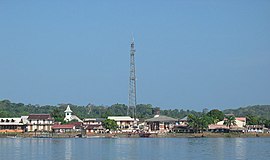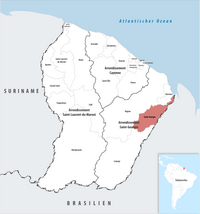Saint-Georges, French Guiana
Saint-Georges | |
|---|---|
Subprefecture and commune | |
 A view of Saint-George from the river | |
 Location of the commune (in red) within French Guiana | |
| Coordinates: 3°53′20″N 51°48′04″W / 3.8889°N 51.8012°W | |
| Country | France |
| Overseas region and department | French Guiana |
| Arrondissement | Saint-Georges |
| Intercommunality | Est Guyanais |
| Government | |
| • Mayor (2020–2026) | Georges Elfort[1] (DVG) |
Area 1 | 2,320 km2 (900 sq mi) |
| Population (2022)[2] | 4,710 |
| • Density | 2.0/km2 (5.3/sq mi) |
| Time zone | UTC−03:00 |
| INSEE/Postal code | 97308 /97313 |
| 1 French Land Register data, which excludes lakes, ponds, glaciers > 1 km2 (0.386 sq mi or 247 acres) and river estuaries. | |
Saint-Georges (French pronunciation: [sɛ̃ ʒɔʁʒ] ⓘ; French Guianese Creole: Senjòrj; sometimes unofficially called Saint-Georges-de-l'Oyapock) is a commune of French Guiana, an overseas region and department of France located in South America. It lies on the Oyapock River (which forms the border with Brazil), opposite the Brazilian town of Oiapoque. The town contains a town hall, a French Foreign Legion detachment,[3] and some hotels (the main ones being Le Tamarin, Coz Calè and the Chez Modestine). Saint-Georges has been one of the three sub-prefectures of French Guiana and the seat of the Arrondissement of Saint-Georges since October 2022.[4]
History
[edit]Several short-lived colonies had been founded on the Oyapock River. In 1604, Charles Leigh founded Oyapoc for Great-Britain.[5]: 31 After a mutiny,[5]: 32 the colony was abandoned in 1606.[5]: 39 In 1620, Roger North tried again, but was forced to abandon the colony in 1629.[6] In February 1677, John Apricius founded a Dutch colony,[7]: 275 and constructed Fort Orange. In June 1677, they were attacked by the French, and shipped back to the Netherlands.[7]: 278 In 1723 or 1724, Fort Saint-Louis was constructed at or near the Dutch fort. In 1734, a Jesuit mission was established at Fort Saint-Louis.[7]: 280 In 1744, they were attacked by Great-Britain, and the settlement was abandoned.[8]
The town was founded on 23 April 1853 as a penal colony and named after a Dutch coin of Saint George which was discovered at the site. The camp was closed down in 1863. The discovery of gold in 1885 in the Camopi River revived the hamlet and the town was officially created in 1947.[9]
The commune is one of the main settlements of the Palikur Amerindians. About 500 Palikur live in the commune.[10] They live in neighbourhoods built specifically constructed for them in the main town,[11] and the village of Trois-Palétuviers.[10]
Geography
[edit]Climate
[edit]Saint-Georges has a tropical monsoon climate (Köppen climate classification Am). The average annual temperature in Saint-Georges is 26.9 °C (80.4 °F). The average annual rainfall is 3,312.4 mm (130.41 in) with May as the wettest month. The temperatures are highest on average in October, at around 28.0 °C (82.4 °F), and lowest in January, at around 26.1 °C (79.0 °F). The highest temperature ever recorded in Saint-Georges was 37.0 °C (98.6 °F) on 22 October 2015; the coldest temperature ever recorded was 17.2 °C (63.0 °F) on 8 November 1958.
| Climate data for Saint-Georges (1991–2020 averages, extremes 1955−present) | |||||||||||||
|---|---|---|---|---|---|---|---|---|---|---|---|---|---|
| Month | Jan | Feb | Mar | Apr | May | Jun | Jul | Aug | Sep | Oct | Nov | Dec | Year |
| Record high °C (°F) | 33.3 (91.9) |
33.4 (92.1) |
34.6 (94.3) |
34.1 (93.4) |
34.5 (94.1) |
33.8 (92.8) |
34.5 (94.1) |
35.8 (96.4) |
36.4 (97.5) |
37.0 (98.6) |
36.4 (97.5) |
35.2 (95.4) |
37.0 (98.6) |
| Mean daily maximum °C (°F) | 29.8 (85.6) |
29.7 (85.5) |
30.2 (86.4) |
30.3 (86.5) |
30.3 (86.5) |
30.9 (87.6) |
31.6 (88.9) |
32.8 (91.0) |
33.8 (92.8) |
34.2 (93.6) |
33.2 (91.8) |
31.1 (88.0) |
31.5 (88.7) |
| Daily mean °C (°F) | 26.1 (79.0) |
26.2 (79.2) |
26.4 (79.5) |
26.6 (79.9) |
26.7 (80.1) |
26.7 (80.1) |
26.8 (80.2) |
27.4 (81.3) |
27.8 (82.0) |
28.0 (82.4) |
27.6 (81.7) |
26.8 (80.2) |
26.9 (80.4) |
| Mean daily minimum °C (°F) | 22.5 (72.5) |
22.6 (72.7) |
22.6 (72.7) |
23.0 (73.4) |
23.1 (73.6) |
22.6 (72.7) |
22.1 (71.8) |
22.0 (71.6) |
21.8 (71.2) |
21.8 (71.2) |
22.1 (71.8) |
22.5 (72.5) |
22.4 (72.3) |
| Record low °C (°F) | 17.5 (63.5) |
17.4 (63.3) |
17.5 (63.5) |
17.9 (64.2) |
18.5 (65.3) |
18.8 (65.8) |
18.5 (65.3) |
17.5 (63.5) |
17.5 (63.5) |
18.2 (64.8) |
17.2 (63.0) |
17.4 (63.3) |
17.2 (63.0) |
| Average precipitation mm (inches) | 394.3 (15.52) |
390.0 (15.35) |
375.9 (14.80) |
471.5 (18.56) |
545.9 (21.49) |
331.2 (13.04) |
207.7 (8.18) |
101.5 (4.00) |
41.1 (1.62) |
44.3 (1.74) |
114.7 (4.52) |
294.3 (11.59) |
3,312.4 (130.41) |
| Average precipitation days (≥ 1.0 mm) | 24.3 | 21.3 | 21.8 | 22.6 | 26.9 | 23.6 | 19.2 | 9.6 | 4.3 | 5.1 | 11.4 | 20.5 | 210.6 |
| Mean monthly sunshine hours | 93.0 | 82.5 | 100.5 | — | 103.1 | 126.3 | 176.3 | 221.9 | 238.4 | 232.8 | 177.2 | 138.6 | — |
| Source 1: Météo-France[12] | |||||||||||||
| Source 2: Meteociel (sun 1981-2010)[13] | |||||||||||||
Transport
[edit]An asphalted road from Saint-Georges to Régina was opened in 2004, completing the National Road 2 (RN2) from Cayenne (the préfecture and largest city of French Guiana) to the Brazilian border and ending the isolation of Saint-Georges. It is now possible to drive on a fully paved road from Saint-Laurent-du-Maroni on the Surinamese border to Saint-Georges on the Brazilian border.[14]
Following an international treaty between France and Brazil signed in 15 July 2005,[15] the Oyapock River Bridge was built, with construction completed in 2011. It was opened for use in March 2017. This bridge is the first land crossing ever opened between France and Brazil, and indeed between French Guiana and the rest of the world (there exists no other bridge crossing the Oyapock River, and no bridge crossing the Maroni River marking the border with Suriname). With the opening of the bridge, it is now possible to drive uninterrupted from Cayenne to Macapá (on the Amazon River), the capital of the state of Amapá in Brazil.[16]
Saint-Georges is served by the Saint-Georges-de-l'Oyapock Airport.
Population
[edit]
|
| |||||||||||||||||||||||||||||||||
| ||||||||||||||||||||||||||||||||||
| Source: INSEE[17] | ||||||||||||||||||||||||||||||||||
See also
[edit]References
[edit]- ^ "Répertoire national des élus: les maires" (in French). data.gouv.fr, Plateforme ouverte des données publiques françaises. 4 May 2022.
- ^ "Populations de référence 2022" (in French). The National Institute of Statistics and Economic Studies. 19 December 2024.
- ^ "Les Forces Armées en Guyane". Ministry of Defence of the French Republic (in French). Retrieved 11 May 2020.
- ^ "Décret n° 2022-1357 du 26 octobre 2022 portant création de l'arrondissement de Saint-Georges (Guyane) et modifiant le décret n° 2004-374 du 29 avril 2004". Légifrance (in French). Retrieved 11 December 2022.
- ^ a b c Williamson, James Alexander (1923). English colonies in Guiana and on the Amazon, 1604-1668. Oxford: Clarendon Press.
- ^ Harris, Sir C. Alexander (2017-05-15). A Relation of a Voyage to Guiana by Robert Harcourt 1613: With Purchas' Transcript of a Report made at Harcourt's Instance on the Marrawini District. Routledge. ISBN 978-1-317-18690-8.
- ^ a b c Martin van den Bel (2017). Fort Orange aan de Wiapoco (in Dutch). Leiden: Sidestone Press. ISBN 978-90-8890-449-3.
- ^ "Un raid corsaire sur l'Oyapock en 1744". Une Saison en Guyane (in French). Retrieved 27 March 2021.
- ^ "Saint-Georges". Americas.fr (in French). Retrieved 11 May 2020.
- ^ a b Clémence Ogeron (2018). "Palikur traditional roundwood construction in eastern French Guiana" (PDF). Journal of Ethnobiology and Ethnomedicine. 14 (1): 28. doi:10.1186/s13002-018-0226-7. PMC 5916587. PMID 29690891.
- ^ "Palikur". Socio Ambiental. Retrieved 26 March 2021.
- ^ "Fiche Climatologique Statistiques 1991-2020 et records" (PDF) (in French). Météo-France. Retrieved September 6, 2022.
- ^ "Normales et records pour Saint Georges (973)". Meteociel. Retrieved 4 June 2022.
- ^ "Le secteur des transports dans les DCOM (Page 37)". Study Lib.fr (in French). Retrieved 11 May 2020.
- ^ "Projet de loi autorisant l'approbation de l'accord entre le Gouvernement de la République française et le Gouvernement de la République fédérative du Brésil relatif à la construction d'un pont routier sur le fleuve Oyapock reliant la Guyane française et l'État de l'Ama". Senate of the French Republic (in French). Retrieved 11 May 2020.
- ^ "Le pont de l'Oyapock inauguré et officiellement ouvert à la circulation". Guyane la 1ère (in French). Retrieved 11 May 2020.
- ^ INSEE (27 June 2023). "Population en historique depuis 1968" (in French).

